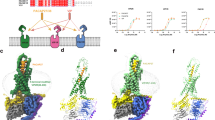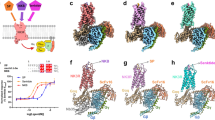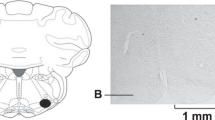Abstract
Urotensin-II (U-II) is a vasoactive ‘somatostatin-like’ cyclic peptide which was originally isolated from fish spinal cords1,2, and which has recently been cloned from man3. Here we describe the identification of an orphan human G-protein-coupled receptor homologous to rat GPR14 (refs 4, 5) and expressed predominantly in cardiovascular tissue, which functions as a U-II receptor. Goby and human U-II bind to recombinant human GPR14 with high affinity, and the binding is functionally coupled to calcium mobilization. Human U-II is found within both vascular and cardiac tissue (including coronary atheroma) and effectively constricts isolated arteries from non-human primates. The potency of vasoconstriction of U-II is an order of magnitude greater than that of endothelin-1, making human U-II the most potent mammalian vasoconstrictor identified so far. In vivo, human U-II markedly increases total peripheral resistance in anaesthetized non-human primates, a response associated with profound cardiac contractile dysfunction. Furthermore, as U-II immunoreactivity is also found within central nervous system and endocrine tissues, it may have additional activities.
This is a preview of subscription content, access via your institution
Access options
Subscribe to this journal
Receive 51 print issues and online access
$199.00 per year
only $3.90 per issue
Buy this article
- Purchase on Springer Link
- Instant access to full article PDF
Prices may be subject to local taxes which are calculated during checkout





Similar content being viewed by others

References
Bern,H. A., Pearson,D., Larson,B. A. & Nishioka,R. S. Neurohormones from fish tails: the caudal neurosecretory system. I. “Urophysiology” and the caudal neurosecretory system of fishes. Recent Prog. Horm. Res. 41, 533–552 ( 1985).
Conlon,J. M., Yano,K., Waugh,D. & Hazon,N. Distribution and molecular forms of urotensin II and its role in cardiovascular regulation in vertebrates. J. Exp. Zool. 275, 226– 238 (1996).
Coulouarn,Y. et al. Cloning of the cDNA encoding the urotensin II precursor in frog and human reveals intense expression of the urotensin II gene in motoneurons of the spinal cord. Proc. Natl Acad. Sci. USA 95, 15803–15808 (1998).
Marchese,A. et al. Cloning and chromosomal mapping of three novel genes, GPR9, GPR10, and GPR14, encoding receptors related to interleukin 8, neuropeptide Y, and somatostatin receptors. Genomics 29, 335–344 (1995).
Tal,M. et al. A novel putative neuropeptide receptor expressed in neural tissue, including sensory epithelia. Biochem. Biophys. Res. Commun. 209, 752–759 (1995).
Stadel,J. M., Wilson,S. & Bergsma,D. J. Orphan G protein-coupled receptors: a neglected opportunity for pioneer drug discovery. Trends Pharmacol. Sci. 18, 430–437 (1997).
Libert,F., Vassart,G. & Parmentier, M. Current developments in G-protein-coupled receptors. Curr. Opin. Cell Biol. 3, 218– 223 (1991).
O'Dowd,B. F. et al. The cloning and chromosomal mapping of two novel human opioid-somatostatin-like receptor genes, GPR7 and GPR8, expressed in discrete areas of the brain. Genomics 28, 84–91 ( 1995).
Ohsako,S., Ishida,I., Ichikawa,T. & Deguchi,T. Cloning and sequence analysis of cDNAs encoding precursors of urotensin II-alpha and -gamma. J. Neurosci. 6, 2730–2735 (1986).
Itoh,H., McMaster,D. & Lederis, K. Functional receptors for fish neuropeptide urotensin II in major rat arteries. Eur. J. Pharmacol. 149, 61–66 (1988).
Pearson,D. et al. Urotensin II: a somatostatin-like peptide in the caudal neurosecretory system of fishes. Proc. Natl Acad. Sci. USA 77, 5021–5024 (1980).
Gibson,A., Wallace,P. & Bern,H. A. Cardiovascular effects of urotensin II in anesthetized and pithed rats. Gen. Comp. Endocrinol. 64, 435–439 (1986).
Hasegawa,J., Kobayashi,Y. & Kobayashi, H. Vasodepressor effects of urotensin II in rats. Neuroendocrinol. Lett. 14, 357–363 (1992).
Yanagisawa,M. et al. A novel potent vasoconstrictor peptide produced by vascular endothelial cells. Nature 332, 411– 415 (1988).
Aiyar,N. et al. Human AT1 receptor is a single copy gene: characterization in a stable cell line. Mol. Cell Biochem. 131, 75–86 (1994).
King,D. S., Fields,C. G. & Fields, G. B. A cleavage method which minimizes side reactions following Fmoc solid phase peptide synthesis. Int. J. Pept. Protein Res. 36, 255–266 ( 1990).
Chambers,J. et al. Melanin-concentrating hormone is the cognate ligand for the orphan G-protein-coupled receptor SLC-1. Nature 400 , 261–265 (1999).
Elshourbagy,N. A. et al. Molecular cloning and characterization of the porcine calcitonin gene-related peptide receptor. Endocrinology 139, 1678–1683 (1998).
Douglas,S. A. & Hiley,C. R. Endothelium-dependent mesenteric vasorelaxant effects and systemic actions of endothelin (16–21) and other endothelin-related peptides in the rat. Br. J. Pharmacol. 104, 311–320 ( 1991).
Acknowledgements
We dedicate this Letter to the memory of our friend and colleague, the late J. M. Stadel. We thank D. Ashton, P. Buckley, T. Covatta, J. Culp, G. Dytko, L. Floyd, P. Hieble, M. Luttmann, G. McCafferty, D. Naselsky, P. Nuthulaganti, P. Ryan and A. Sulpizio for their assistance and comments during the preparation of this manuscript. We thank B. O'Dowd, University of Toronto for the rat GPR14 cDNA clone.
Author information
Authors and Affiliations
Corresponding author
Rights and permissions
About this article
Cite this article
Ames, R., Sarau, H., Chambers, J. et al. Human urotensin-II is a potent vasoconstrictor and agonist for the orphan receptor GPR14. Nature 401, 282–286 (1999). https://doi.org/10.1038/45809
Received:
Accepted:
Issue Date:
DOI: https://doi.org/10.1038/45809
This article is cited by
-
Protective effect of urotensin II receptor antagonist urantide and exercise training on doxorubicin-induced cardiotoxicity
Scientific Reports (2023)
-
Urantide alleviates atherosclerosis-related liver and kidney injury via the Wnt/β-catenin signaling pathway in ApoE(−/−) mice
Herz (2023)
-
The network map of urotensin-II mediated signaling pathway in physiological and pathological conditions
Journal of Cell Communication and Signaling (2022)
-
Zebrafish: an important model for understanding scoliosis
Cellular and Molecular Life Sciences (2022)
-
Bioinformatic analysis and functional predictions of selected regeneration-associated transcripts expressed by zebrafish microglia
BMC Genomics (2020)
Comments
By submitting a comment you agree to abide by our Terms and Community Guidelines. If you find something abusive or that does not comply with our terms or guidelines please flag it as inappropriate.


